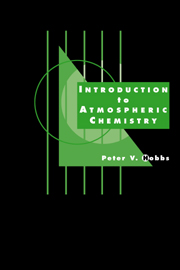Book contents
- Frontmatter
- Contents
- Preface
- 1 Evolution of the Earth's atmosphere
- 2 Half-life, residence time, and renewal time of chemicals in the atmosphere
- 3 Present chemical composition of the atmosphere
- 4 Interactions of solar and terrestrial radiation with atmospheric trace gases and aerosols
- 5 Sources, transformations, transport, and sinks of chemicals in the troposphere
- 6 Atmospheric aerosols
- 7 Cloud and precipitation chemistry
- 8 Tropospheric chemical cycles
- 9 Air pollution
- 10 Stratospheric chemistry
- Appendix I Exercises
- Appendix II Answers to exercises in Appendix I and hints and solutions to the more difficult exercises
- Appendix III Atomic weights
- Appendix IV The International System of Units (SI)
- Appendix V Some useful numerical values
- Appendix VI Suggestions for further reading
- Index
7 - Cloud and precipitation chemistry
Published online by Cambridge University Press: 05 June 2012
- Frontmatter
- Contents
- Preface
- 1 Evolution of the Earth's atmosphere
- 2 Half-life, residence time, and renewal time of chemicals in the atmosphere
- 3 Present chemical composition of the atmosphere
- 4 Interactions of solar and terrestrial radiation with atmospheric trace gases and aerosols
- 5 Sources, transformations, transport, and sinks of chemicals in the troposphere
- 6 Atmospheric aerosols
- 7 Cloud and precipitation chemistry
- 8 Tropospheric chemical cycles
- 9 Air pollution
- 10 Stratospheric chemistry
- Appendix I Exercises
- Appendix II Answers to exercises in Appendix I and hints and solutions to the more difficult exercises
- Appendix III Atomic weights
- Appendix IV The International System of Units (SI)
- Appendix V Some useful numerical values
- Appendix VI Suggestions for further reading
- Index
Summary
Early studies of atmospheric chemistry emphasized trace gases and homogeneous gas-phase reactions. However, in the latter part of the twentieth century, increasing attention was given to atmospheric aerosols (see Chapter 6), chemical reactions on aerosol surfaces (see Chapter 10), and the role of clouds in atmospheric chemistry. In this chapter we consider how clouds remove particles and gases from the air, some of the chemical reactions that can occur within cloud droplets, and how these processes modify the chemical composition of cloud water and precipitation, as well as some other important properties of clouds. Finally, we will discuss the effects of cloud processing on modifying atmospheric aerosols.
Overview
We will organize our discussion of cloud and precipitation chemistry around the processes illustrated schematically in Figure 7.1.
Clouds form when air becomes slightly supersaturated with respect to liquid water (or in some cases with respect to ice). The most common means by which this is achieved in the atmosphere is through the ascent of air parcels, which results in the expansion and cooling of the air below its dew point. When the air becomes slightly supersaturated with respect to water (by a few tenths of 1%), water vapor begins to condense onto some of the articles in the air to form a cloud of small water droplets. This process, by which a portion of the atmospheric aerosol (called cloud condensation nuclei, or CCN) nucleate the formation of cloud droplets, and are thereby incorporated into cloud water as insoluble and soluble components, is referred to as nucleation scavenging.
- Type
- Chapter
- Information
- Introduction to Atmospheric Chemistry , pp. 111 - 142Publisher: Cambridge University PressPrint publication year: 2000
- 1
- Cited by



